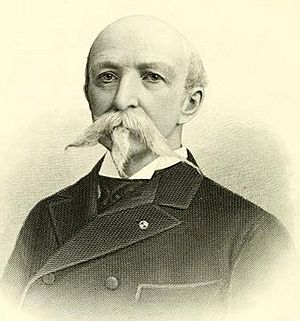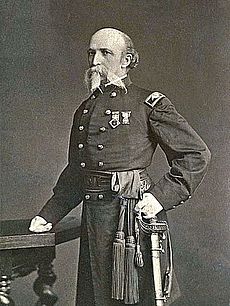John Mason Loomis facts for kids
Quick facts for kids
John Mason Loomis
|
|
|---|---|

1892
|
|
| Born | January 5, 1825 |
| Died | August 2, 1900 (aged 75) Chicago, Illinois, US
|
| Resting place | Rosehill Cemetery, Chicago |
| Nationality | American |
| Education | public schools |
| Occupation | businessman, lumberman, u.s. army colonel |
| Known for | developing Mason County and Ludington, Michigan |
| Signature | |
John Mason Loomis (January 5, 1825 – August 2, 1900) was a nineteenth-century American businessman and lumber tycoon of Chicago famous for helping develop the city of Ludington, Michigan. He was a Colonel in the Illinois militia, which was mobilized as part of the Union Army during the American Civil War and fought in several major battles. Loomis was also a leader of charitable causes.
Early life and education
Loomis was born at Windsor, Connecticut, on January 5, 1825. Of English descent, his parents were Colonel James Loomis and Abigail (nee Sherwood Chaffee) Loomis. His father was a native of Windsor who was a farmer, merchant, and miller. His mother was a native of Greenfield Hill, Connecticut. She was a descendant of a family that produced a large number of successful medical doctors.
Loomis attended public schools of Connecticut as a child. He worked in his father's store when he was a teenager and there received his initial business training.
Business career
At age 23 in 1848, Loomis took over an existing lumber merchant business in Milwaukee, Wisconsin. The business was successful and in 1852 it moved to Chicago. With James Ludington of Milwaukee he formed a partnership called Loomis & Ludington. The business was a success until 1861, when Loomis entered the American Civil War as a colonel. In 1864, he left military service and returned to Chicago, only to find his lumber business had been mishandled and destroyed. Since he was interested in this type of business he became a commission merchant. He was successful at this and later became a partner with John McLaren, forming John Mason Loomis & Company. His company on South Water Street was for many years the leading lumber firm of Chicago.
Loomis became the treasurer of the Pere Marquette Lumber Company of Ludington when it was formed in 1869. Through his efforts and others of the lumber company the Mason County, Michigan, seat was moved from the village of Lincoln in Mason County to the town of Ludington. Loomis along with Delos L. Filer pledged $1,000 towards a building for the county offices in Ludington which was finished being constructed in 1874. Loomis became the president of this lumber company in 1879.
Loomis determined through experimental investigation of boring for salt that the brine of flowing salt water from a well could be distilled to produce usable salt. The Pere Marquette Lumber Company pioneered burning scrap lumber to operate salt distilleries. Other local entrepreneurs followed Loomis' techniques and a salt industry came about in northwestern Michigan. The village of Pere Marquette benefited from these local lumber and salt industries and developed into the city of Ludington.
Military service
Loomis became a Captain in the State militia at the age of 18. He became a Navy Midshipman, but became frustrated as he awaited mobilization. He joined the Merchant Marine, traveling to India and other points, returning in 1845 to Chicago.
When the American Civil War broke out in 1861 Loomis' patriotic spirit was aroused and he was eager to get into the fray. At the time he was already a first Lieutenant in the Chicago Light Guard who had earned himself a reputation for being a devoted and skilled military leader. This prompted Governor Yates to request that Loomis take command of a regiment for service in the field. Yates' request had the support of several influential men in Chicago, to which Loomis accepted. In August 1861, Loomis assumed command of the 26th Illinois Infantry Regiment as colonel.
Loomis' regiment participated inter alia in the Battle of Island Number Ten, the Battle of Iuka, the Siege of Corinth, the Siege of Vicksburg, the Battle of Jackson, Mississippi, the Second Battle of Chattanooga and the Battle of Farmington, Tennessee. As reported in the St. Louis Globe Democrat, he acquitted himself well – valiantly and recklessly – as he rallied his men at the Second Battle of Chattanooga. He led the 26th at the Battle of Missionary Ridge. One memorial tribute described this accomplishment as "a remarkable achievement for a regiment of citizen soldiers." Colonel Loomis was hoping for a promotion to Brigadier General, and was recommended twice by General Ulysses S. Grant for the position, but was always turned down. Loomis also served with the 16th Corps Support Group. During his military career, Colonel Loomis had fought in 57 battles and skirmishes and had marched along with his men for more than 6,900 miles; he resigned his commission on April 30, 1864 due to fatigue. He returned to Chicago and became a prominent real estate owner, while also becoming very active in support of veteran affairs.
Colonel Loomis' wife was with him at the front lines while he was stationed in Missouri. She was in charge of a group of nurses.
Personal life
Loomis' father was Colonel James Loomis of Windsor, Connecticut. James admired a seventeenth century Major by the name of John Mason who was an officer under Sir Thomas Fairfax. John Mason became a famous officer of the colonial forces in the Indian Wars of New England after he immigrated to America. James named his son after Mason because of Mason's military aptitude.
John Mason Loomis married Mary Hunt in 1849. She was the daughter of Milo Hunt of Chenango County, New York.
Loomis and his three brothers and one sister all lost their children tragically one way or another within their lifetimes. They decided then with their resources to form the Loomis Institute, which would help educate young boys and girls. They incorporated the Loomis Institute into the Loomis Chaffee School in 1874. It is a New England boarding and day school in Windsor, Connecticut, that, for the first four decades of its operation, offered free education to those between twelve and twenty years of age.
Loomis was on the board of directors of the Chicago Relief and Aid Society. This was a Chicago charity for those left homeless and destitute after the fire of 1871. He gave money and time to this charity and other similar charities for twenty years.
He was a devout Episcopalian and active in Chicago's Grace Episcopal Church and a big contributor. In politics Loomis was a strong Republican and, though not considered a politician, he was active in the selection of good men for office.
Loomis helped organize George H. Thomas Post Number 5 of the Grand Army of the Republic. In 1879, Loomis organized the Illinois Commandery of MOLLUS, the Military Order of the Loyal Legion of the United States, and became its commander in 1884, succeeding Philip Sheridan. Loomis served as Treasurer 1879, head of the U.S. Volunteers (1880–1883) and Commander 1884.
Loomis retired in 1885. He built a home at 55 Lake Shore Drive, Chicago, Illinois. He died in Chicago on August 2, 1900, and is interred at Rosehill Cemetery.
Legacy
In 1910, his wife left over $1.1 million as an endowment to the "Loomis Institute" for charitable purposes.


